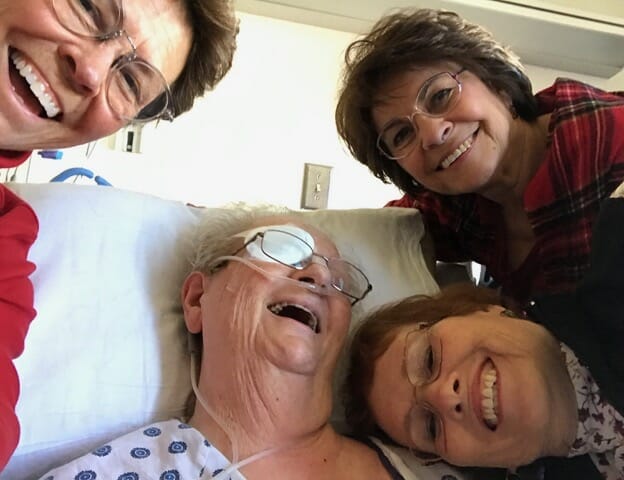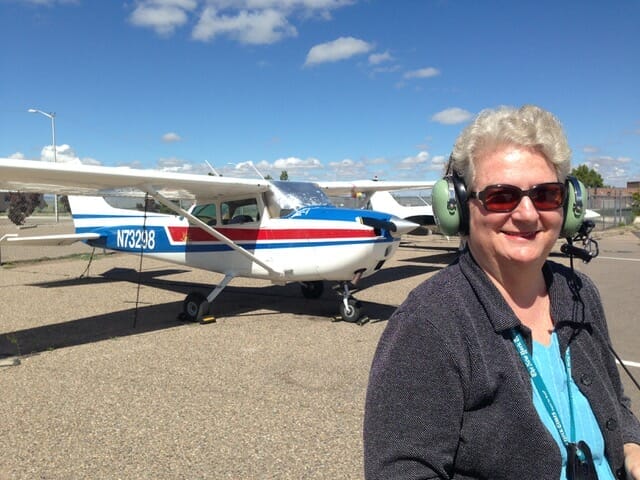Chemotherapy is no fun: we knew it wouldn’t be, but we weren’t prepared for what was coming.
It was mom’s first round for breast cancer, and she was prepared for it. On her third day after the first treatment … she still felt great. She was tired, perhaps, but we still went wig shopping for the anticipated hair loss, and used a special walker chair to help her with fatigue. That night, she was really tired. We also know that chemotherapy looks different for each patient, so we tried to be as supportive as possible, even though mom just didn’t feel good, got a fever, and didn’t want to eat. We called the doctor and were encouraged to give her ibuprofen, and just let her rest.

She didn’t want to eat. After 24 hours, we knew we had to get her to eat something, or she would never get her strength back. Frantic, I went to the kitchen and started identifying all her favorite foods, the ones she had eaten recently, and the ones I thought she’d be willing to try. I prepared cottage cheese, melon, some lunch meat wrapped around cheese, some peanut butter and a cracker. She had a bit of each, but they just didn’t taste good. Finally, I remembered chocolate! I grabbed a chocolate covered ice cream bar from the freezer and she took a few bites of that.
In my memory of this time … it was this hour of serving her food which I replay most in my mind.
For a large part of my career I’ve worked to create food safety education materials at the Learning Games Lab at New Mexico State University. I understand at-risk audiences: I know that the young, the old, the pregnant and the immunocompromised are at risk. I can tell you about norovirus and how it’s different from other foodborne pathogens. I can tell you about campylobacter and the importance of not washing your chicken. I know folks want to use a food thermometer with their hamburgers to prevent the risk of E. coli contamination. I could have told you that previous listeria recalls included soft cheeses and lunch meat, melon, peanut butter and ice cream.
At that moment, with my mother, I wasn’t a food safety educator or a PhD scholar or even an informed caretaker of someone with cancer: I was a daughter desperate to get her mom to eat something.
Mom immediately and dramatically declined. First, she couldn’t walk without help, then she couldn’t walk or stand at all. Her fever increased. Within 8 hours she was unresponsive. After an ambulance ride and oxygen at the emergency room, she revived and spoke with us: feeling much better. The hospital ran so many tests: with none showing anything. We all recognized that chemotherapy was hard, and assumed that was the problem.
The next day at the hospital, she started feeling worse again. She had trouble with her hands, then she had trouble with her neck and jaw. She had trouble swallowing. She couldn’t speak. She was once again unresponsive. She was intubated and tested again. It wasn’t until the second day in the Intensive Care Unit that one of the tests run in the emergency room came back with an answer: she had listeria meningitis.
As soon as I heard the diagnosis, my mind returned to that hour where I was trying to get her to eat. The doctor told us how incredibly rare this diagnosis was, how few people survive it. He told us how listeria is found everywhere, that she could have contracted it in the week before. I know this: but I also know that listeria is primarily spread through food. I know that it can also make for a fairly difficult day for a normal person, but can be extremely serious to those individuals at risk.
Amazingly, after a few weeks, she once again awoke from meningitis with double vision as her only remaining symptom. She was able to talk to us and hug us, and make plans to be home for Christmas as soon as she regained the strength in her legs at a physical therapy hospital.
My mom died December 9th, five weeks after receiving her first treatment for chemotherapy, after becoming one of the ‘at risk’ population we hear so much about. On a Sunday afternoon, while my dad stepped out for lunch, she quite suddenly died at the rehabilitation hospital. Because it was at the rehab hospital, her death was considered ‘observed’ and no autopsy was performed. We assume it was a heart attack or a stroke as a result of the extreme stress her body had been through.

I can’t tell you for sure that she would have survived chemo without these complications, nor can I confirm listeria was in any of those foods she ate that night she got so sick. I can’t tell you if she was a breast cancer victim or a heart disease victim or a stroke victim or a food borne illness victim.
But I can tell you this:
For every story like the death of my mother, there are stories of other people’s mothers, fathers, sisters and friends who successfully survived chemotherapy. There are stories of people who ate melon and ice cream and peanut butter and soft cheese, and they didn’t get sick. There are stories of people in rehabilitation hospitals who did regain the strength in their legs, and did get home in time for Christmas.
These stories — the stories where everything turned out ok and no one gets a food borne illness — are less compelling, but equally important. We have a tremendously safe food supply. The United States works hard to fund and promote education, enforcement, and research to keep our food supply safe. Every day, cooks and chefs, growers, line workers, farm workers, and transporters work to learn more, to take every step they can to prevent food borne illness. I appreciate that because I know how hard it is to see the cases of food borne illness which we prevent. What happened to my Mom is statistically rare, but she’s the only Mom I had. Every death matters; but deaths that are preventable are especially difficult. I’m grateful to the people who work so hard to keep others from getting sick, and my hope is that in understanding her story, we’ll be even better at preventing other illnesses.
This is my new pledge: I wish to create new food safety educational materials for families and caretakers of those with cancer. When our loved one is diagnosed, we are so easily overwhelmed by all the things we need to do, that thinking of food safety is often not a big priority — it wasn’t for me. In sharing this story, I hope to find the right partner to fund and help me design materials to educate this audience. Now that I know better, I know we can help others do better.



